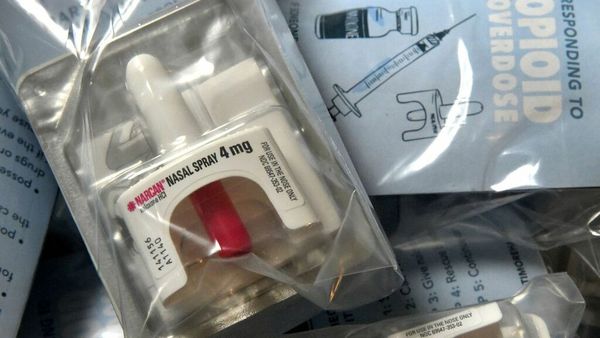On Jan. 14, Hartford police issued a warning stating they recently recovered fentanyl 50 times more potent than the kind typically tested across New England.
Police did not specify where they recovered the drugs, but the issue of fentanyl was close to mind. A 13-year-old student at Sport and Medical Sciences Academy overdosed on the drug while at school Jan. 13, and later died. The following day, police said a subsequent search of the school revealed nearly 40 small bags of fentanyl packed for street-level sale.
In the warning released Jan. 14, police repeated a claim that has since been widely scrutinized: “The strength and potency of this product can be deadly to anyone coming in contact with it, including absorption through the skin,” they wrote.
The latter part of the claim is untrue, according to medical and addiction experts, who fear the circulation of these claims could spread unnecessary fear and negatively impact harm reduction efforts in the future.
“Proving a negative, as in, this could never be a problem, is potentially difficult. But in this situation, it really isn’t so difficult,” said Dr. Charles McKay, former president of the American College of Medical Toxicology and associate medical director of the Connecticut Poison Control Center.
“I am unaware … of a legitimate, scientifically reviewed, published case report of dermal powder fentanyl exposure resulting in severe toxicity and death,” said Dr. Suzanne Doyon, medical director of the Connecticut Poison Control Center.
It’s simply not how the drug works, the doctors said.
What is fentanyl?
Fentanyl is a synthetic opioid 50 to 100 times more potent than morphine and typically administered intravenously to treat severe pain, such as for cancer patients or post-surgical patients.
It is cheaper to produce than other opioids, which are usually derived from the opium poppy. Though considered safe in a medical environment, the drug has begun to infiltrate the illicit opioid market, and its potency poses a fatal risk to users.
It’s also a larger substance and doesn’t absorb well through the skin, McKay said. It is “physically impossible” that one could develop symptoms just minutes after coming into contact with the drug, he added.
Pharmaceutical companies have more recently produced dermal fentanyl patches ― but only after more than 10 years of development, Doyon said.
These highly technical patches often contain large quantities of fentanyl in a membrane, and are applied with adhesive and occlusive dressing.
“There’s a huge difference between that and someone who gets a little bit of white powder on the hands,” Doyon said.
Lt. Aaron Boisvert, the Hartford police spokesperson who wrote the warning, clarified the claim with The Courant on Thursday and reiterated the dangers posed by the highly potent opioid.
“We’ve always had training bulletins and things that [said] you’re not supposed to touch this stuff because it can be absorbed through the skin. Apparently that is no longer the case,” Boisvert said.
“However, if you touch it and touch your eye later, your nose later, then it can potentially kill you. I’m not going to say you can touch fentanyl. This is dangerous stuff.”
Ocular ingestion is thought to pose more of a risk than dermal absorption, but medical experts said the dangers are mitigated with basic safety precautions, like handwashing.
“If people come in casual contact with fentanyl, they should wash their hands and avoid touching their face, mouth or nose,” until they wash their hands, said Dr. Matt Griswold, chief of the Division of Toxicology at Hartford Hospital.
Decontamination
Experts also questioned the rigorous decontamination process at the Sport and Medical Sciences Academy, which kept the school closed until Wednesday.
School administrators placed the school under a “Code Yellow” alert after learning of the overdose — meaning students and staff had to stay put — and did not distribute lunches to students.
Jason Thody, Hartford police chief, said at a press conference Jan. 13 that students were required to walk through a solution of bleach and OxyClean before leaving the school.
A certified state contractor continued the decontamination process over the weekend in the areas where bags of the drug were found. The direction to treat the school as a “Hazmat situation” came from the Drug Enforcement Administration, Boisvert said.
McKay said the process was “completely unnecessary and benefits nobody.” While these chemicals would succeed in degrading the fentanyl, the likelihood of significant quantities of fentanyl-laced powder being tracked out of school on the shoes of the students is slim.
“I suppose if [students] licked their shoes or something, they might get a dose, but that doesn’t seem very likely,” McKay said. “It would be better to focus people on the problem that does exist, which is the widespread availability and use of very potent opioids with no idea what is in them.”
The Sport and Medical Sciences Academy reopened Wednesday with a two-hour delay, with extra support staff on site and resources for students and staff.
Whatever the rationale for closing the school for decontamination, “it would have nothing to do with preventing subsequent exposures,” McKay said.
Mark Jenkins, executive director of the Connecticut Harm Reduction Alliance, said he was concerned with the optics of the response. “The message that sends to the community is hysteria,” he told The Courant.
Jenkins and other harm reduction advocates worry that spreading claims that fentanyl can kill you just by touching it, or that hazmat suits are needed to decontaminate, spreads stigma around opioids and makes intervention less likely in the future. People who witness an overdose, or first responders, may be hesitant to treat a victim with Narcan, for example.
The decontamination process at the school is not replicated at other scenes where overdoses occur, according to Peter Canning, EMS coordinator at UConn John Dempsey Hospital.
“If you treated every [overdose] scene the way they treat some of these hazmat scenes, you would need to put tape around the city of Hartford,” Canning said.
Where did these claims begin?
The mistaken belief that fentanyl can be lethal to touch has been particularly pervasive among law enforcement officials as police and other emergency personnel started to respond to more fatal overdoses over the last decade.
In 2016, the DEA released a training video for officers called “Fentanyl: A Real Threat to Law Enforcement” that said dermal contact with the drug could be fatal.
Videos and testimonies of officers claiming to experience overdoses soon began to circulate widely, in part thanks to a plethora of misleading news reports.
Several medical organizations have attempted to counter these claims in the years since.
In 2017, the American College of Medical Toxicology and the American Academy of Clinical Toxicology released a joint position statement saying “incidental dermal absorption is unlikely to cause opioid toxicity.”
Despite fentanyl’s potency, the “risk of clinically significant exposure to emergency responders is extremely low,” the statement reads.
As for the testimonies, McKay noted that the symptoms described by first responders “are generally not what you’d expect to see with opioid exposure.”
Symptoms like dizziness or an elevated heart rate are more akin to stress or panic attacks, experts said.
Still, these incorrect beliefs have stuck around, and guidance from medical institutions is not always clear.
The Centers for Disease Control and Prevention, for example, in 2020 updated its guidance for first responders when handling fentanyl, but still warns of the dangers of skin absorption on its general fentanyl page online.
It can be hard to correct misinformation once it gets out the first time, Canning said, and deferred to a favored quote from Jonathan Swift: “Falsehood flies, and truth comes limping after it, so that when men come to be undeceived, it is too late; the jest is over, and the tale hath had its effect.”
———










